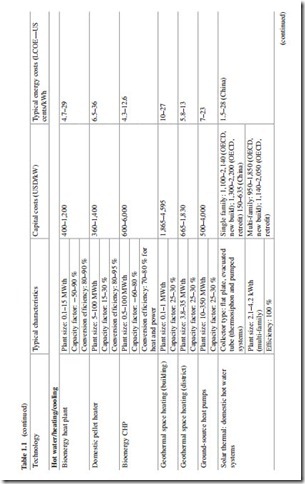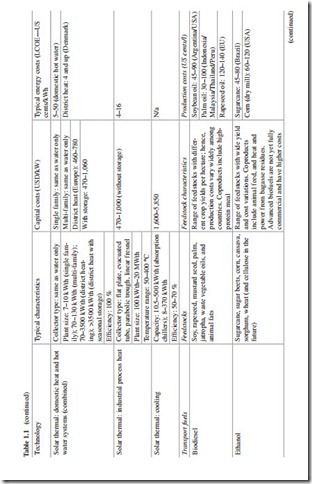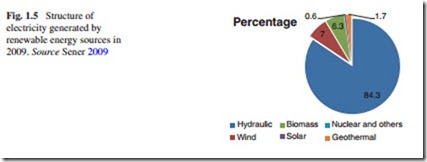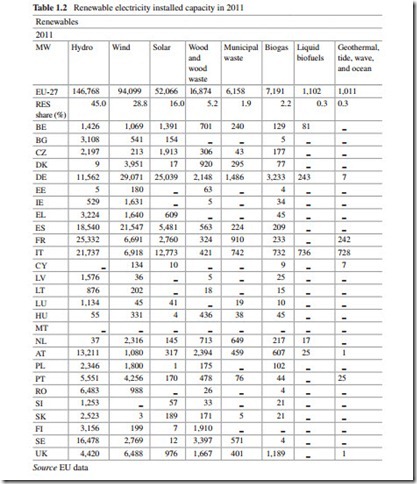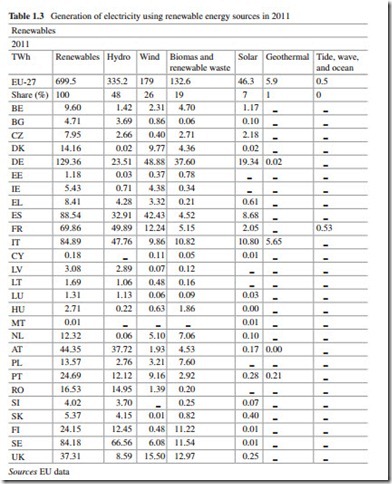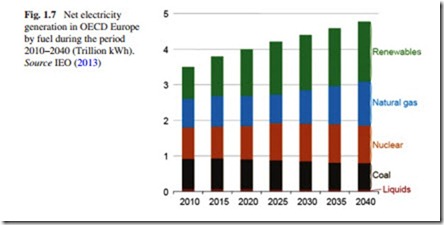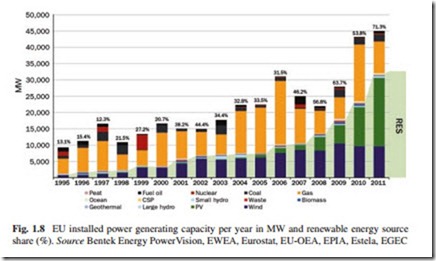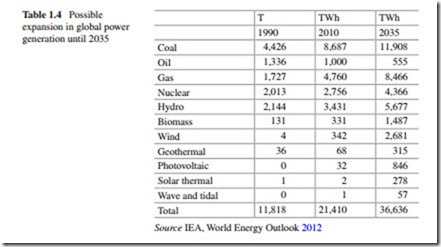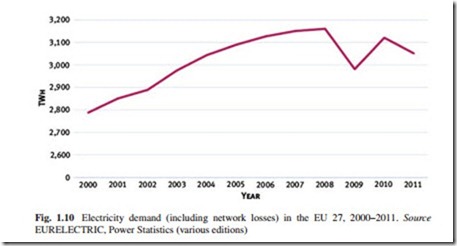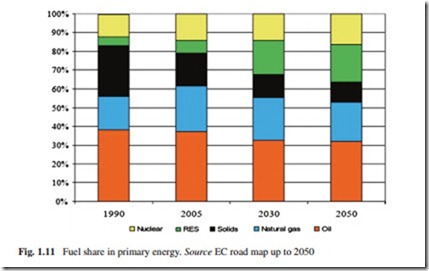Electricity Generation
In September 2010, the EC published its new EU energy scenarios entitled “EU Energy Trends to 2030.” The EC expects that in the coming decades, 64 % of the total new energy capacity to be renewable energy, 17 % natural gas, 12 % coal, 4 % nuclear power, and 3 % oil. Renewable energy sources as a whole are the third world’s largest contributor to global electricity production. They accounted, in 2004, for almost 18 % of the world’s electricity production after coal (40 %), and natural gas (19 %), but ahead of nuclear (16 %), oil (7 %), and non-renewable waste (7 %). In 2009, the use of renewable energy sources for electricity generation reached 19.1 %; this means an increase of 1.1 % with respect to 2004 or around 0.22 % per year of increase during the past five years.
The percentage in the participation of the different renewable energy sources for electricity generation in the European region in 2009 is included in Fig. 1.5. In 2012, the use of renewable energy sources for electricity generation reached 4,699.2 TWh or 20.8 %; this represents an increase of 1.7 % with respect to 2009.
Total electricity generation from renewable energy sources is expected to increase 3.1 % per year during the coming years, a percentage that is almost the same that the one reached during the period 1999–2009. The renewable share of the world’s electricity generation is expected to grow from 18 % in 2004 to 23 % in 2035; this means an increase of 5 % in the next thirty years. Hydroelectricity leads the field.
During the coming decades, the electricity’s share of the total energy market in OECD countries is expected to grow from 24 % in 1970 to 40 % in 2020, an increase of 16 %, as more efficient and intelligent processes are introduced into industry, business, homes, and transportation. On the other hand, it is expected that the electricity generated in OECD Europe will increase by an average of 1.2 % per year, from 3.4 trillion kWh in 2008 to 4.8 trillion kWh in 2035; this repre- sents an increase of 41.2 %. Because most of the countries in OECD Europe have relatively stable populations and mature electricity markets, most of the region’s growth in electricity demand is expected to come from those nations with more robust population growth (including Turkey, Ireland, and Spain) and from the newest OECD members (including the Czech Republic, Hungary, Poland, and Slovenia), whose projected economic growth rates exceed the OECD average. In addition, with environmental concerns remaining prominent in the region, there is a concerted effort in the industrial sector to switch from coal and liquid fuels to electricity (IEO 2011).
Renewable energy is OECD Europe’s fastest growing source of electricity generation, and it is expected to increase by 2.5 % per year through 2035. The increase is almost entirely from wind and solar. OECD Europe’s leading position worldwide in wind power capacity is expected to be maintained through 2035, with growth in generation from wind sources, averaging 6.4 % per year, even considering the no enactment of additional legislation to limit greenhouse gas emissions.
The growth of non-hydropower renewable energy sources in OECD Europe is encouraged by some of the world’s most favorable renewable energy policies. The
EU set a binding target to produce 21 % of electricity generation from renewable sources by 2010 (Directive 2001/77/EC, 2001) and reaffirmed the goal of increas- ing renewable energy use with its December 2008 “climate and energy policy,” which mandates that 20 % of total energy production must come from renewable energy sources by 2020 (European parliament 2008).
It is important to stress that the IEO (2011) report does not anticipate that all future renewable energy targets in the EU will be met on time. In fact, the 2010 renewable energy shares of 20 member states and the EU as a whole were at the level of or above 2010 commitments set out in their national plans and above the first interim target for 2011/2012. However, a further analysis undertaken for the EC modeling current policy initiatives and various barriers to renewable energy development reveals a less optimistic outlook for 2020. The analysis, which pro- vides a conservative estimate of renewable energy sources growth compared to other sources, limits policies to those already in places and reflects the economic crisis, ongoing administrative and infrastructure barriers, and policy and support schemes disruption. This suggests future investment may decline or be delayed unless further measures are taken by EU member states to achieve their targets. Given investment lead times of eight to ten years, any major disruption of invest- ment today will have significant impact on renewable energy production over the coming years and has become a cause for concern. Hence, many EU member states will need further measures to ensure the achievement of their targets. In con- clusion, 15 EU member states failed to reach their indicative 2010 targets for the share of renewable energy in the electricity mix and in the transport sector, and 22 EU member states failed to achieve their indicative 2010 target of 5.75 % (EC report SWD (2013) COM (2013), 2013).
The failure to comply with national plans is most evident in the wind sector. According to EU Member State plans, wind capacity is expected to reach 213 GW in 2020 (169 GW onshore and 44 GW offshore). Electricity generation from off- shore capacity is planned to reach 140 TWh. However, according to the commis- sion’s analysis, it may only reach 43 TWh or 30.7 % of the plan approved, due to reduced national efforts and infrastructure difficulties. Despite the recent strong growth in the onshore wind industry in recent years, EU member state plans for onshore wind production 354 TWh may fall short. Further efforts will be needed to reinforce measures and improve infrastructure, or only an estimated 210 TWh might be achieved; this represents 59.3 % of the target approved (EC report SWD (2013) COM (2013), 2013). The failure in the onshore wind production will have a negative impact on the total wind generation. It is foreseen that total wind pro- duction falls short of expectations. Whereas EU member state plans foresee wind generation of almost 500 TWh, the current trends point to the risk of achieving only half of it (253 TWh).
Some individual countries provide economic incentives to promote the expan- sion of renewable electricity. For example, Germany, Spain, and Denmark—the leaders in OECD Europe’s installed wind capacity—have enacted feed-in tariffs that guarantee above market rates for electricity generated from renewable energy sources and, typically, last for 20 years after a project’s completion. As long as European governments support such price premiums for renewable electricity, robust growth in renewable generation is likely to continue. Exceptionally generous FiTs have been falling out of favor in recent years, however. Before September 2008, Spain’s solar subsidy led to an overabundance of solar PV projects. When the Spanish FiT was lowered after September 2008, a solar PV supply glut or “solar bubble” resulted, driving down the price of solar panels and lowering prof- its throughout the industry (Greenwire 2009). The Spanish government is now set to reduce its tariffs by a further 45 % for large ground-based sites, in view of the country’s large public deficit and the fear of creating another solar bubble (IHS Global Insight 2010). Germany has taken a similar approach in 2011 and cut its FiT for ground solar PV units by 15 %. Italy, with the third-largest installed solar PV capacity in OECD Europe, is also lowering its solar FiT since June 2011, after experiencing a financially unsustainable 128 % increase in solar PV output between November 2009 and November 2010 (World Gas Intelligence 2011).
From Fig. 1.6, the following can be stated: Coal is expected to continue to be the fuel with the highest participation in electricity generation until 2040, followed by the use of natural gas, renewable energy sources, nuclear power, and liquids in this order. It is expected also that the participation of liquids in the generation of electricity at world level will be minimum in comparison with other types of energy sources and, in some countries, will reach 0 %.
In 2011, the major installed electricity capacity within the EU is in hydropower sector with 45 % of the total, followed by wind with 28.8 %, solar with 16 %, and biomass with 7.1 % (see Table 1.2). This situation will not going to change significantly during the coming years, despite all efforts that many EU countries are ready to make in order to increase the use of wind, solar, and biomass for the generation of electricity.
Hydropower, wind, and waste were the three major renewable energy sources in the generation of electricity in the EU in 2011 (see Table 1.3). It is expected that this situation will not change during the coming years.
In the specific case of solar PV, the story and expectations are the following. According to the EC report (SWD (2013) COM (2013)), the strong growth of the last few years has seen a surplus created that will continue for some time. However, it is important to highlight that rigid national support schemes were generally unable to adapt rapidly enough to such falling costs, raising profits, and creting a rate and scale of installations in some countries almost excessive in a time
of general economic crisis. The result has been sudden and unpredictable changes to a number of national support schemes, which will, again, curtail investment such that there remains a risk that the current surplus of solar photovoltaic over planned levels (46 TWh rather than 35 TWh) will disappear and become a deficit by 2020.
The EU estimates that in 25 of the 28 EU member states, electricity demand has increased by an average of 1.7 % per annum since 1990. In 15 of these states, elec- tricity demand had an annual growth rate of nearly 1.9 %. In the new EU member
states, electricity demand initially exhibited limited annual growth (from 1990 levels) of around 0.2 %, but in the second half of the past decade, it dropped to around 1.6 % per annum. The EC expects that total electricity generated in 25 of the 28 EU member states will grow by 1.4 % annually from 2000 to 2030.
However, according to Fig. 1.7, in the case of OECD Europe, after 2015, the use of renewable energies will be the type of energy source with the highest participation in electricity generation until 2040, followed by natural gas, nuclear power, coal, and liquids in this order. It is expected that the use of liquids for the generation of electricity in the OECD Europe will continue to be very small until 2040 and in several countries will not be part of their energy mix.
It is important to highlight that some renewable energy sources are currently at early development stage, insofar as they often have higher costs than other energy sources, though they form part of a sector with rapid technological developments and significantly declining production costs resulting from early economies of scale and technology learning (Impact Assessment 2011).
The non-hydro energy sources are the biggest contributors to the growth. The legislations adopted within the EU encourage the use of renewable energy sources for electricity generation. Taking into account the above-mentioned situation, the role of the different renewable energy sources, particularly hydropower, wind, and solar energy in the world energy balance, is expected to become increasingly important in the future.
On the other hand, and according to Fig. 1.8, the participation of renewable energy sources in the generation of electricity increased significantly since 2006. Renewable energy sources accounted for 12.5 % of the EU’s energy consumption in 2010, an increase of 4 % in five years, and the energy production from renewa- ble energy sources grew by 12 % in that year alone. This represents a continuation of the rising consumption of renewable energy sources that has been experienced in recent years, which is itself a consequence of the policy of greening the energy mix. It is expected that this trend will continue up to 2050 when the participation
of renewable energy sources in the generation of electricity could reach over 25 %9 (Energy Market in the EU 2012).
Hydropower accounted for 15 % of power generation capacity in Europe in 2011. This means that among Europe’s power plants, it also ranks well ahead of the new renewable energy sources such as wind energy and solar PV. The years of generous subsidies for wind and solar energy are helping to narrow the gaps, however. For example, wind power generated merely 2 % of electricity capac- ity in 2000, but by 2011, the share had already risen to 10 %; this represents an increase of 8 %. Solar PV technology has grown at a similarly brisk pace: From not being a factor in 2000, it had already reached a share of close to 5 % by 2011. Hydropower plays a key role in large scale and important concepts for Europe’s future. For example, the offshore grid initiative of the North Sea states, which is intended to produce an additional 100 GW of clean electricity capacity in Europe, is counting on modern hydropower technologies such as pumped-storage generating plants in Norway in addition to wind power. These help to better even out the erratic peaks in wind power generation.
The potential hydropower theoretically to be tapped in Europe (excluding Russia) totals nearly 2,600 TWh per year. Currently, 64 % of the economically viable potential (870 TWh per year) is being exploited. It follows that Europe leaves no less than 36 % of its hydropower potential, or more than 300 TWh per year, unused, even though related power generation would pay off. Hydropower potential is not equally distributed across Europe by any means. There is still ample potential, even far away from Scandinavia, in the Alpine countries or
Southeastern Europe, not least in Albania and Turkey. That is why hydropower— along with the new renewable energy sources—will also be one of the winners in the European power plant sector in the coming decades (Auer 2013).
A further increase in the participation of renewable energy sources in the generation of electricity in the EU will progress more slowly due to the assumed phasing out of operational aid to mature renewable energy technologies. The use of renewable energy sources in transport is expected to contribute 10 % in 2020 in order to comply with the EC Directive; this share is expected to increase to 13 % by 2050. However, the pace of electrification in the transport sector is expected to remain slow during the period considered: Electric propulsion in road transport does not make significant inroads by 2050.10
From Fig. 1.9, the following can be stated: Wind, natural gas, and solar PV are the three energy sources with the highest increase in their participation in the net electricity generation during the period 2000–2013. It is expected that this trend will continue without change during the coming years.
The evolution of new capacities in the last 13 years explains the current situation of the electricity markets in the EU. The addition of dozens of GW of wind, natural gas, and solar PV has changed the electricity landscape in Europe, while at the same time, fuel oil, coal, and nuclear power plants were decommissioned (Masson et al. 2013).
The IEA forecasts that by 2035, global electricity output will have increased by more than 71 % (compared with 2010) (see Table 1.4). Hydropower remains the leading renewable energy source with a share of 15 %, ahead of wind power (7 %) and biomass (4 %). Despite posting high growth rates, solar power (including con- centrated solar power) will have reached only a comparatively low level of 3 % by 2035; this will nevertheless be thrice as high as geothermal (1 %). Whereas the
hydropower share will remain roughly the same, the share of the remaining renew- able energy sources will increase from 4 to 15 %. Looking at percentage shares provides only half the picture, however, as all renewable energy sources will in fact achieve volume growth by 2035.
It is also revealing that only wind power can boost the absolute volume of electricity generated faster than hydropower. In this context, admittedly, offshore wind in particular still has to justify the promising outlook forecast for it. One certainly realistic prospect seems to be that about half of the world’s new additional hydropower capacity of around 650 GW will be installed in the globally aspiring countries of Brazil, China, and India. It is also commercially interesting that even Europe still has more than enough space for the continued expansion of hydro- power plant (Auer 2013), but public opinion in many European countries is not in favor of installing new biggest hydropower plants for the generation of electricity during the coming years.
There is considerable fuel switching in final and primary energy demand fore- seen during the coming years. In primary energy, the dominance of fossil fuels is expected to diminish with its share falling from 83 and 79 % in 1990 and 2005, respectively, to only 64 % in 2050; this represents a decrease of 19 % with respect to 1990. While renewable energy sources and nuclear energy are expected to account for 36 % of primary energy in 2050, they are expected to reach a significantly higher share in the 2050 electricity mix. Energy sources not emitting CO2 are expected to supply 66 % of electricity output in 2050, with 40 % of renewable energy sources and 26 % from nuclear. However, any reduction in the share of nuclear energy in the energy mix at world level will have to be compensated with fossil fuels, particularly natural gas, because it will be very difficult to increase further the already foresee- able high participation of renewables in the energy mix in 2050.
According to EU Road Map 2050 (2011), it is expected that the demand for electricity will continue to rise during the coming years, and there is a considerable shift toward the use of renewable energy sources for the generation of electricity in many European countries, with a strong increase in the use of wind power for this specific purpose. However, the European Commission expects final power demand in 2020 to be 11 % lower than it did in 2009 (2,956 TWh gross final consumption in EU27, instead of 3,336 TWh). In reality, therefore, the Commission does not expect EU power demand to increase above its 2008 peak until after 2020. This economic reality has had a impact on demand for new power installations for all generation technologies.
Electricity demand has mirrored GDP patterns. After recovering in 2010, it has shrunk again in 2011, although not hitting the low of 2009 (see Fig. 1.10). While it is true that 2010 was a fairly cold year compared to the milder winter of 2011, pre- liminary information from the statistical offices of different EU countries suggests a further decrease in demand for 2012—so the weather might be an element, but the crisis appears to be the main reason for the observed demand drop.
As a result of the large increase in renewable energy sources in power generation, the load factor of the system decreases given the more widespread use of technologies that run only a limited number of hours per year. It is also expected that the investment in power generation will increase during the coming years, driven by the use of renewable energy sources and natural gas.
According to Fig. 1.11, in 2050, oil will continue to be the main primary energy source, followed by natural gas and renewable energy sources, nuclear energy, and solid sources in this order. It is clear from Fig. 1.11 that the participation of oil in the primary energy supply during the next 60 years will be lower than the level reached in 1990. The major increase during this period will be in renewable energy sources.
On the other hand, it is important to highlight the following: Developing countries, where live around three-quarter of the humankind, consume around 13 % of the world energy, while the industrialized countries consume 87 %. However, this last group of countries has to satisfy only the energy needs of around 18 % of the
population of the planet, while the other group around 82 %. It is estimated that 1,600 million of people live today without electricity in the world, the immense majority of them in developing countries. It is expected that in 2030, around 1,400 million of people will continue to live without electricity. According to con- servative calculations, more than 60 % of the increase in the demand of world primary energy up to 2030 will come from Third World countries, mainly from the Asian region, particularly China and India. Many of the countries have to dedicate around 50 % of their total exports to import the energy resources that they need to guarantee their economic and social development, spending around US$74,000 million for this concept. It is expected that this figure can reach US$170,000 mil- lion in the first decades of the twenty-first century (Morales Pedraza 2008).
Several countries in the developed world depend on the import of fossil fuel to satisfy its fundamental energy needs. In almost 67 % of them, this dependence reached between 70 and 75 %. In Europe, the import energy dependency is rising. The region currently imports 56 % of its energy needs—and is on track to reach 70 % or more in the next twenty to thirty years—the challenge is big. Europe’s fossil fuel resources are running out fast, and the environment is suffering as a result of the current energy supply structure. In 2030, the EU is expected to be importing 84 % of its natural gas, 59 % of its coal, and 94 % of its oil needs (Zervos and Kjaer 2008).11 If Europe cannot make domestic energy more competitive in the next 20–30 years, then around 70 % of the EU’s energy requirements, compared to 56 % today, will be met by imported products from regions threatened by insecurity. This
energy import dependency, combined with the increased influence of politics over the energy market, is making Europe very vulnerable to disruptions in the supply of energy. Secure access is becoming a national security priority worldwide, and the pursuit of secure supply disrupts the free trade regime (Huiskamp 2007).
Finally, it is important to highlight the following: The participation of the OECD countries in the world energy demand is expected to diminish from 58 to 47 % in 2030; this represents a decrease of 11 %. In the cases of Russia and Central and Eastern European countries, the energy demand will decay until 10 %.

